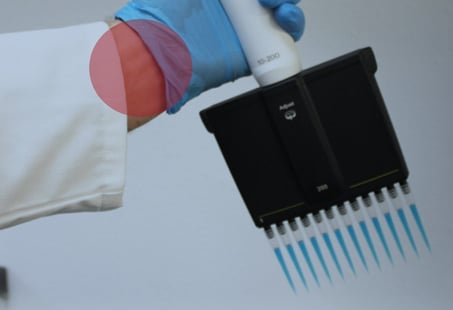Repetitive Strain Injury (RSI) is a term used to describe pain or injury – usually of the wrist – from repetitive movements or overuse of an instrument e.g. a pipette. Long hours of pipetting and lab work can lead to RSI if proper preventative steps are not taken. Educate yourself and your lab group in RSI so that you can all reduce your chances of experiencing RSI in the future.
The Signs of Repetitive Strain Injury
Pain from RSI can be felt in the muscles, nerves, and/or tendons due to local inflammation. The signs of RSI can range from soreness or a tingling sensation, right up to a significant lack in physical strength. If it is recognized and diagnosed, RSI is treatable in the early stages of the condition. However, chronic RSI is far more difficult to relieve. If RSI is ignored, it can lead to permanent nerve damage and potentially carpal tunnel syndrome.
Avoiding Repetitive Strain Injury
The best way to avoid RSI when working in the lab is to perform proper pipetting technique, take frequent breaks, always keep your extremities in a relaxed position and use ergonomically designed equipment. When working at the lab bench, sit or stand in an ergonomic position (don’t hunch over). Try to keep your arm and shoulder in a neutral position as much as possible and maintain good posture. Take breaks every 20-30 minutes when performing repetitive actions like pipetting and stretch occasionally. The speed at which you work can also play a role in RSI.
Importance of Ergonomic Pipettes in Preventing Repetitive Strain Injury
The equipment used in the lab is often the culprit of RSI. Using heavy pipettes or those with stiff plunger buttons, will greatly increase your chances of RSI. We suggest using pipettes that are lightweight and have a soft and smooth plunger stroke. The BenchMate Light Pipette from Oxford Lab Products is a great example of an ergonomic pipette. The unit is lightweight and has a smooth plunger force – 70% less force is required to depress the plunger and eject a tip. You should also ensure that you do not use excessive force when mounting pipette tips. Most people aren’t aware that one of the least ergonomic movements during pipetting is the act of tip mounting and ejection.
Repetitive Strain Injury is a serious condition that can worsen over time and should not be taken lightly. Educate yourself and your fellow lab members to take preventative action and watch out for the early signs of Repetitive Strain Injury. Make an educated decision when selecting pipettes for your lab and think ergonomics.


